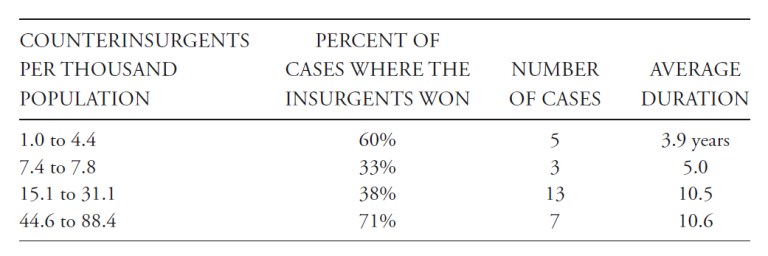And then there is this article: Troop-to-Task: A Russian Invasion of Ukraine
What catches my attention about this article is the discussion of whether “troop-to-task” ratios, also known as tie-down ratios, sometimes also known as force ratios; should be measured based upon population or based upon insurgent strength.
To quote from his article: “Throughout the Iraq and Afghanistan campaigns, American analysts and military officials referred to a 20:1,000 (2%) troop-to-population ratio for successful counterinsurgency.”
He also notes: “These troop-to-population security ratios are notoriously unreliable and have weak empirical basis for planning.”
That is more polite than how I refer to them in private. I did discuss this subject on pages 70-71 of my book America’s Modern Wars.
He then states: “Another popular way to analyze troop requirements in through troop–to-insurgent ratios.”
Popular? I have not seen anyone do this in recent times. I do have a book published on the subject (America’s Modern Wars). Perhaps I am missing out on something that is going on in the basement of the Pentagon.
He does note that “This approach falls apart at step one: Counting insurgents.”
I have a chapter on the subject (Chapter 11: Estimating Insurgent Force Size, pages 115-120). It is possible. It is not perfect or easy; but doing something vague and difficult is better than doing something that is conceptually flawed. To date, I have not seen anyone else do anything further on estimating insurgents. My work was a tentative first cut on the subject. My customers were completely uninterested in this analysis, and nothing further was done. Clearly something further needs to be done. I think that is better than doing something that is conceptually flawed.
I have discussed this before on this blog and in my book: America’s Modern Wars. My discussion of the previous RAND work on the subject is on pages 70-71. It includes the following table from our work:

If anyone can tell me from that table where a 2% figure could come from, have at it.
Listed below are a collection of four relevant blog posts on the subject (there are some 1,288 posts on this blog). We do have categories like “Insurgency and Counterinsurgency,” “Force Ratios” and “Estimating Insurgent Force Size” this blog. We have done a few posts on the subject.
Needless to say, I think that basing the “troop-to-task” ratios on population is at best marginally relevant. For example, the troop-to-task ratio for Vietnam was 88.4. We did not win that one. On the other hand, when the Symbionese Liberation Army (SLA) with its two dozen members, raised hell in San Francisco and Los Angeles in the early 1970s, doing a political assassination, kidnapping Patty Hearst, and robbing banks, we took care of it using the LA police. We did not need to deploy 2% of the population of the United States (estimated at 213 million in 1974) to deal with the SLA. We did not need to raise over 4 million troops to suppress this insurgency.
I do think the size of the insurgency is relevant.
Related posts:
Force Ratios and Counterinsurgency | Mystics & Statistics (dupuyinstitute.org)
Force Ratios and Counterinsurgency II | Mystics & Statistics (dupuyinstitute.org)
Force Ratios and Counterinsurgency III | Mystics & Statistics (dupuyinstitute.org)
Force Ratios and Counterinsurgency IV | Mystics & Statistics (dupuyinstitute.org)
and many, many others….
